
Tiger was a weekly British comics periodical published by Amalgamated Press, Fleetway Publications and IPC Magazines from 11 September 1954 to 30 March 1985. The title was initially launched in a large tabloid size to mimic newspapers; while it featured some action-adventure stories Tiger contained a large number of sport strips. The most famous of these was "Roy of the Rovers", which debuted in the first issue and was the comic's most popular feature, eventually transferring to its own comic in 1975. Tiger would go on to become one of the company's longest-running titles, with 1,573 issues published before being merged with Eagle in 1985. Over the course of its run, Tiger featured columns by numerous famous sports figures, including Ian Botham, Geoff Boycott, Tony Greig, Trevor Francis and Charlie Nicholas.
The Amalgamated Press (AP) was a British newspaper and magazine publishing company founded by journalist and entrepreneur Alfred Harmsworth (1865–1922) in 1901, gathering his many publishing ventures together under one banner. At one point the largest publishing company in the world, AP employed writers such as Arthur Mee, John Alexander Hammerton, Edwy Searles Brooks, and Charles Hamilton. Its subsidiary, the Educational Book Company, published The Harmsworth Self-Educator, The Children's Encyclopædia, and Harmsworth's Universal Encyclopaedia. The company's newspapers included the Daily Mail, the Daily Mirror, The Evening News, The Observer, and The Times. At its height, AP published over 70 magazines and operated three large printing works and paper mills in South London.
Angus Peter Allan was a British comic strip writer and magazine editor who worked on TV Century 21 in the 1960s and Look-in magazine during the 1970s. Most commonly known as Angus Allan and sometimes credited as Angus P. Allan, he was responsible for original comic strip adaptations of numerous popular TV series.

Lion was a weekly British comics periodical published by Amalgamated Press from 23 February 1952 to 18 May 1974. A boys' adventure comic, Lion was originally designed to compete with Eagle, the popular weekly comic published by Hulton Press that had introduced Dan Dare. It debuted numerous memorable characters, including Captain Condor, Robot Archie, Paddy Payne and the Spider. Lion lasted for 1,156 issues before being merged with stablemate Valiant.

Valiant was a weekly British comics periodical published by Fleetway Publications and later IPC Magazines from 4 October 1962 to 16 October 1976. A boys' adventure comic, it debuted numerous memorable characters, including Captain Hurricane, The Steel Claw and Mytek the Mighty. Valiant lasted for 712 issues before being merged with stablemate Battle Picture Weekly.
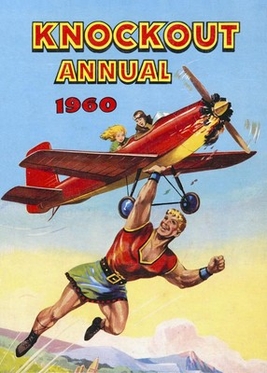
Thunderbolt Jaxon is a fictional Australian-British Golden Age comic book superhero. He first appeared in Thunderbolt Jaxon Comics #1, published in Australia by Amalgamated Press in 1949. While the character debuted in an Australian comic it was created by British staff working at Amalgamated Press' UK headquarters. The character has since appeared intermittently in British comics, and was revived by Wildstorm in 2006 for a five-issue mini-series written by Dave Gibbons with art by John Higgins.

Captain Condor is a British comic character who has appeared in eponymous strips published by Amalgamated Press and Fleetway Publications. The character, a space pilot, first appeared in the launch issue of weekly comic Lion on 23 February 1952 and was created by Frank S. Pepper.
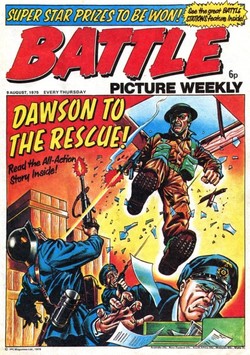
Arthur Geoffrey Campion was a British comics artist who drew adventure strips for Amalgamated Press/IPC.

Thriller Comics, later titled Thriller Comics Library and even later Thriller Picture Library, was a British comic book magazine, published in series of digest sized issues by the Amalgamated Press, later Fleetway Publications, from November 1951 to May 1963: 450 issues in all, originally two per month, later four.
Leonard James Matthews was a British editor, publisher, writer and illustrator of comics and children's magazines, best known as the founder of the educational magazine Look and Learn.

Knockout was a weekly British comics periodical published by Amalgamated Press and later Fleetway Publications and IPC Magazines from 4 March 1939 to 16 February 1963. A boys' adventure comic, the title ran for 1227 issues before being merged with Valiant.

Girls' Crystal was a British weekly fictional anthology publication aimed at girls. Published by Amalgamated Press and later Fleetway Publications from 26 October 1935 to 18 May 1963. Uniquely for an Amalgamated Press title, Girls' Crystal began as a story paper before transforming into a picture comic between editions, with the new format debuting on 21 March 1953. It ran for a combined total of 1432 issues before merging with School Friend in 1963.
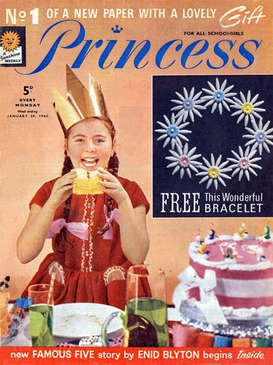
Princess was a British weekly girls' comic anthology published by Fleetway Publications and, later, IPC Magazines. The first version was published between 30 January 1960 and 16 September 1967, and featured a mix of comic strips, text stories and a large proportion of features; it was merged with Tina to form a new title - Princess Tina - after 399 issues.

June was a British weekly girls' comic anthology published by Fleetway Publications and IPC Magazines from 18 March 1961 to 15 June 1974. Designed as a response to DC Thomson's hit Bunty, June never quite eclipsed its Scottish rival but was nevertheless a success on its own terms, reaching 631 issues before being merged into Tammy in 1974.
Battler Britton is a British comics character created by Mike Butterworth and Geoff Campion. He first appeared in Amalgamated Press' Sun in 1956, and later featured in Knockout, and the long-running digest titles Thriller Picture Library, Air Ace Picture Library, and War Picture Library.
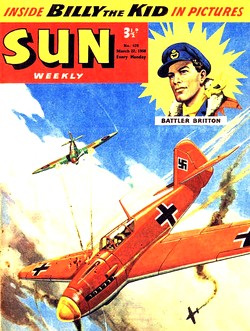
Sun was a weekly British comics periodical published by J. B. Allen, Amalgamated Press and Fleetway Publications between 11 November 1947 and 17 October 1959. During this time it was also known as Sun Comic, Sun Adventure Weekly, The Cowboy Sun Weekly, The Cowboy Sun, The Sun and Sun Weekly at various points, and ran for 551 issues before merging with Lion.

Jack o' Justice is a British comic character who has appeared in eponymous strips published by Fleetway Publications. The character is a highwayman adventurer, first appeared in the anthology title Radio Fun on 22 August 1956. The strip began as altered reprints of a Dick Turpin strip from the comic Sun but after being revived in the pages of Valiant became popular enough that new adventures were commissioned. The character was partnered with Moll Moonlight in his adventures - a rare example of a prominent female character in boys' comics of that time. The strip was succeeded in 1966 by Jack Justice, featuring a descendant of the characters.
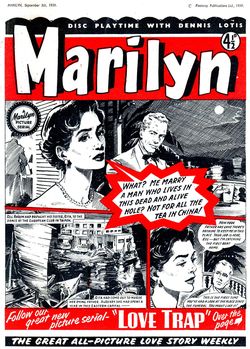
Marilyn was a British girls romance comic published weekly by Amalgamated Press and Fleetway Publications between 19 March 1955 and 18 November 1965. It ran for between 547 and 549 issues before merging with Valentine.
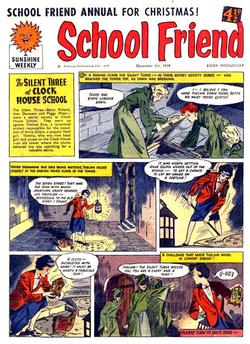
School Friend was a British weekly girls' comic anthology published by Amalgamated Press and Fleetway Publications from 20 May 1950 to 23 January 1965. Considered the first British girls' comic and bearing the same name as a popular story paper previously published by Amalgamated Press, School Friend was a huge success and effectively kickstarted the genre in British publishing.
















